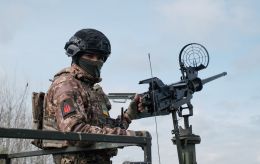Inside new US–Russia peace plan for Ukraine: What we know so far
 Photo: US President Donald Trump (Getty Images)
Photo: US President Donald Trump (Getty Images)
The administration of US President Donald Trump has prepared a draft peace agreement on Ukraine, which is currently being actively discussed with Europe and representatives of Moscow.
Find out everything currently known about the peace plan in RBC-Ukraine's report.
According to several American media outlets, the peace plan was approved by Trump and developed in consultations between representatives of Washington and Moscow. The document itself has not been officially released. Still, its content is already being actively discussed by diplomats, experts, and the media, as the proposed terms mean radical concessions by Russia and a de facto change in the US position on the war in Ukraine.
The plan includes several elements that Kyiv has long considered unacceptable: from territorial compensation for the Kremlin to a significant reduction in Ukraine's defense capabilities. At the same time, it was developed without Ukraine's participation, which also raises questions among partners.
Peace plan main provisions
According to Western media reports, the draft peace plan involves the transfer of territories in eastern Ukraine to Russia, primarily those parts of the Donetsk and Luhansk regions that currently remain under Kyiv's control. This effectively means agreeing to Russia's demands regarding the entire Donbas region, even though it would take Russia years to capture these territories by military means.
At the same time, the latest data from analysts show that Ukraine still controls about 14-15% of the region's territory. In Trump's version, these areas would become demilitarized, formally under Russian control, but without Russian troops stationed there.
The peace plan also stipulates that Russia would allegedly pay rent for control over Donbas. Under this scenario, Ukraine would not formally change its borders, but would allow Moscow to control the territory in exchange for payment.
Separate discussions are underway regarding the conditions for the Kherson and Zaporizhzhia regions, where it is proposed to freeze the front lines at their current positions, with certain details yet to be specified.
In addition to the territories, the plan provides for large-scale restrictions on the Ukrainian army: a reduction in numbers, a ban on foreign military missions, and restrictions on weapons systems, in particular long-range strike weapons, which Ukraine currently uses to hit targets in Russia's rear.
The document also mentions the curtailment of US military aid and a ban on the deployment of Western troops on Ukrainian territory after the end of the war. In effect, this means renouncing NATO membership, a key demand Russia has been pushing since 2014.
In response, Moscow declares its readiness to give guarantees that it will not launch new attacks on Ukraine or other European states, and even promises to formalize this at the legislative level.
In addition, the media note that Trump's peace plan includes a clause on the official recognition of the Russian language and guarantees for the Russian Orthodox Church in Ukraine — positions that the Kremlin has been promoting for decades.
Peace plan preparation
The peace plan was prepared quietly over several weeks and, according to Western media reports, was coordinated by Trump's special envoy Steve Witkoff and Russian negotiator Kirill Dmitriev, head of the Russian sovereign wealth fund. They met in the US, specifically in Miami, where they discussed the parameters and preparation of the text.
At the same time, according to Western media sources, Ukraine was informed after the fact and was not invited to participate in the drafting of proposals. However, an informed source at RBC-Ukraine reported that Trump's peace plan does not correspond to Ukraine's interests.
According to media reports, the United States made it clear to President Volodymyr Zelenskyy that Ukraine must accept the framework prepared by Washington for ending the war with Russia.
FT correspondent Christopher Miller reported that Ukraine had received an urgent proposal agreed upon by Dmitriev and Witkoff. The document was handed over to the head of the National Security and Defense Council, Rustem Umerov, and, according to sources, its content appears to be a proposal effectively equivalent to Ukraine's surrender.
In the US, Trump's actions are also not viewed unequivocally. Some American politicians and diplomats learned about the document from the press, as its development did not undergo full interagency coordination. At the same time, Trump and his team believe that it is necessary to move towards ending the war at any opportunity, because prolonging the struggle only increases Russian pressure on the front, and Ukraine's position is weakening due to corruption scandals and resource depletion.
US officials hint that the draft peace plan may be adjusted after consultations with Kyiv and Europe, although not everyone believes it is possible to achieve a genuine transformation.
Earlier, US Secretary of State Marco Rubio confirmed the development of potential ideas for Trump's peace plan.
In addition, Republican Senator Lindsey Graham says he was not aware of the new peace plan. At the same time, he stresses that no agreement would have a chance of success without strong US military support for Ukraine and measures to limit the Kremlin's financial ability to wage war.
Sources: Axios, NBC News, Financial Times, The Economist, The New York Times, The Wall Street Journal, The Times.

